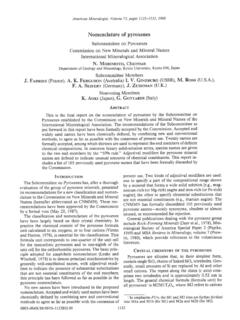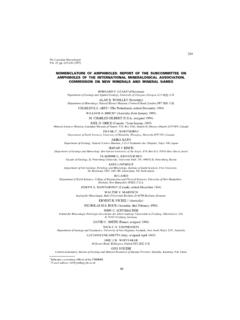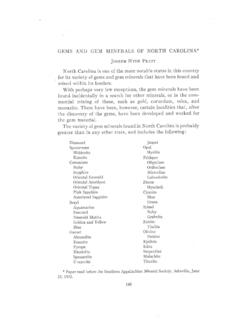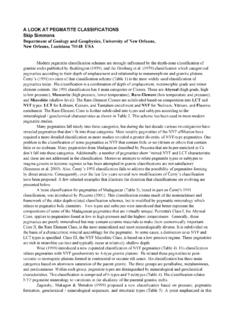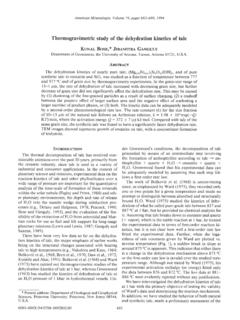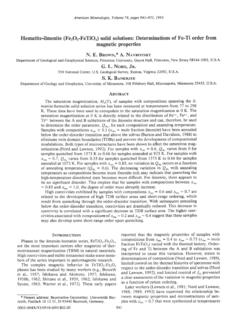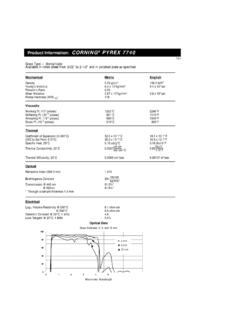Transcription of A SIMPLE TEST FOR THE DETECTION OF THE BERYLLIUM …
1 82 NOTES AND NEWSA SIMPLE TEST FOR THE DETECTION OF THEBERYLLIUM MINERALSIManv H. frbrcnnr2 AND CnanlBs E. WnrrB3 The berylliu'm minerals in hand specimens are frequently confusedwith topaz, quartz, apatite, garnet and other minerals. A SIMPLE butspecific qualitative chemical test for BERYLLIUM would preclude any un-certainty. This paper describes a rapid fluorescent microtest which canbe used with assurance for the DETECTION of this element. It is essentiallyan adaptation of the qualitative (1) and quantitative (2) proceduresdeveloped for the determination of apparatus required consists of a platinum loop, several smallpyrex test tubes, a porcelain spot plate (optional), and a source ofultra-violet light. The light source should preferably be a B-H-4 GeneralElectric high-pressure mercury lamp equipped with a Corning Filter#5874.
2 These lamps have a strong emission at 3654 A and are excellentactivators for the production of the fluorescence in the reaction involvedhere. However, Iamps which produce light rich in 2fi7 L radiationcan be used. The fluorescence produced by the shorter wavelengthsQ$7 b is appreciably weaker than that induced by the longer wave-lengths (3654 A) consequently when such a lamp is used the solutionsto be examined should be held about 2 inches from the light reagents required are:Fusion mixture, (3:1) sodium carbonatelborax acid, (1 : 1).Sodium hydroxide, dihydroxyanthraquinone (quinizarin), concentration in acetone, keptin a glass-stoppered bottle;or1-amino-4-hydroxyanthraquinone, in acetone, kept in a glass-stoppered bottle.
3 (Dropping pipettes with rubber bulbs should not be used for either of the dye solu-tions, as acetone in contact with rubber reacts to form a brilliant blue fluorescentsolution which ruins the test.)The TestMake a bead of the fusion mixture in the loop of a platinum wire inthe usual manner. Add a single small crystal (about 40 mesh) of the1 Published by permission of the Director, Bureau of Mines, U. S. Department of Chemist, Eastern Experiment Station, Bureau of Mines, College Park, Chemist Consultant, Eastern Experiment Station, Bureau of Mines, College Park, AND NEWS mineral to be tested, or touch the bead to some of the powdered again to decompose the sample. Dissolve the melt in 6-8 drops of(1:1) hydrochloric acid contained in a small test tube by placing theplatinum wire and bead in the acid and warming.
4 Cool the solution, andadd 2 drops of either quinizarin or addition of the dye, do not expose the solution to sunlight as stronglight decomposes the dye and ruins the test. Add sodium hydroxide drop-wise until the solution is purple. Avoid an excess, as this destroys thetest. Expose the solution to ultra-violet light in a darkened room andexamine for If BERYLLIUM is present a strong orange-redfluorescence (5700-6400 A) is solution may be examined in the original test tube or it may betransferred into a non-fluorescent porcelain spot plate, or a drop of thesolution may be placed on a piece of filter paper. The spot plate givesthe clearest iron or manganese hydroxide precipitates upon addition of thesodium hydroxide, a condition which will occur if the mineral is helvite,the following procedure should be a small amount (1-2 mg.)
5 Of the powdered material in a smalltest tube and boil with 6-8 drops of 1: t hydrochloric acid. Make alkalinewith an excess of sodium hydroxide. Filter the solution into a clean testtube, cool the solution and add 2 drops of either dye solution. Addhydrochloric acid dropwise until the purple color disappears and thensodium hydroxide until the solution is again purple. Examine forfluorescence as when present in sufficient amounts will give the same reac-tion. However, if the small samples recommended are used, a negativetest will be obtained with lithium-bearinr study reported in this paper was under the general direction ofJ. B. Zadra, Chief, College Park Division, Metallurgical Branch, U. of Mines, and the immediate supervision of Alton Gabriel, andMorris Slavin.
6 The writers are indebted to Alton Gabriel and MorrisSlavin for comment and Wnrrr, C. E., aNo Lown, C. 5., Inil. anil Eng. Chem.,13, 809 (1941).2. Frorcuen, M. H., Wnrrr, C. E., eNn Suerrel, M. S., A fluorimetric method for thedetermination of BERYLLIUM in orcs: Ind. and, Eng. Chem., anal. Ed., 18 [3].
